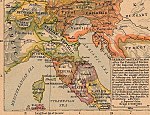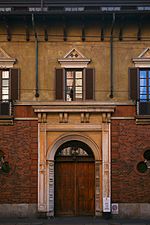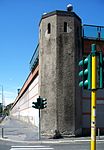Golden Ambrosian Republic
1440s in Europe1450 disestablishments in Europe15th century in ItalyFormer republicsHistory of Milan ... and 2 more
Italian statesStates and territories established in 1447

The Golden Ambrosian Republic (Lombard: Aurea Republega Ambrosiana; Italian: Aurea Repubblica Ambrosiana; 1447–1450) was a short-lived government founded in Milan by members of the University of Pavia with popular support, during the first phase of the Milanese War of Succession. With the aid of Francesco Sforza they held out against the forces of the Republic of Venice, but after a betrayal Sforza defected and captured Milan to become Duke himself, abolishing the Republic.
Excerpt from the Wikipedia article Golden Ambrosian Republic (License: CC BY-SA 3.0, Authors, Images).Golden Ambrosian Republic
Piazzale Francesco Baracca, Milan Municipio 1
Geographical coordinates (GPS) Address Nearby Places Show on map
Geographical coordinates (GPS)
| Latitude | Longitude |
|---|---|
| N 45.466666666667 ° | E 9.1666666666667 ° |
Address
Casa Laugier
Piazzale Francesco Baracca
20123 Milan, Municipio 1
Lombardy, Italy
Open on Google Maps











